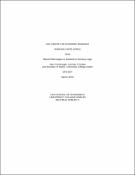Options
Mixed marriages in Ireland a century ago
Author(s)
Date Issued
2014-03
Date Available
2014-03-27T14:38:36Z
Abstract
This paper explores the characteristics associated with marriages between Roman Catholics and members of other religious denominations ('mixed marriages') in 1911 Ireland. Using the recently-digitized returns of the 1911 census of population, we find that such marriages were relatively rare, varying from two to three percent of all mar- riages in Dublin to less than half a percent in Connacht. However, at the turn of the century in the Dublin area mixed marriages represented 12 per cent or more of mar- riages where at least one of the partners was a non-Catholic. When mixed marriages did occur the Catholic partner was more likely to be the wife. Using regression analysis we examine the individual characteristics of the partners to these marriages and find a number of characteristics significantly associated with them. However, the strength and even the direction of predictors like socioeconomic status vary substantially across regions, most notably between Ulster and the rest of Ireland. In Ulster mixed marriages tended to occur between partners in lower socioeconomic positions, whereas in the rest of Ireland the partners tended to be from higher social strata. Since the religion of the children born to mixed marriages was a contentious issue, we match our sample of partners of mixed religions to their children and find that the religion of the children was strongly influenced by the mothers religion. Couples of mixed religions had lower fertility than the general population, even when the influence of socioeconomic class and other potentially confounding variables is allowed for. This, as well as the evi- dence of higher infant-child mortality among families of mixed marriages, potentially indicates a lack of family and social support due to the general public disapproval of couples who married across the religious divide.
Sponsorship
Not applicable
Type of Material
Working Paper
Publisher
University College Dublin. School of Economics
Series
UCD Centre for Economic Research Working Paper Series
WP14/07
Language
English
Status of Item
Not peer reviewed
This item is made available under a Creative Commons License
File(s)
Loading...
Name
WP14_07.pdf
Size
374.78 KB
Format
Adobe PDF
Checksum (MD5)
31192e637f15fc01de7920a769d6e7a6
Owning collection